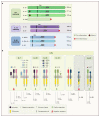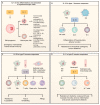Interleukin-1 and Related Cytokines in the Regulation of Inflammation and Immunity
- PMID: 30995499
- PMCID: PMC7174020
- DOI: 10.1016/j.immuni.2019.03.012
Interleukin-1 and Related Cytokines in the Regulation of Inflammation and Immunity
Abstract
Forty years after its naming, interleukin-1 (IL-1) is experiencing a renaissance brought on by the growing understanding of its context-dependent roles and advances in the clinic. Recent studies have identified important roles for members of the IL-1 family-IL-18, IL-33, IL-36, IL-37, and IL-38-in inflammation and immunity. Here, we review the complex functions of IL-1 family members in the orchestration of innate and adaptive immune responses and their diversity and plasticity. We discuss the varied roles of IL-1 family members in immune homeostasis and their contribution to pathologies, including autoimmunity and auto-inflammation, dysmetabolism, cardiovascular disorders, and cancer. The trans-disease therapeutic activity of anti-IL-1 strategies argues for immunity and inflammation as a metanarrative of modern medicine.
Copyright © 2019 Elsevier Inc. All rights reserved.
Figures




Similar articles
-
A Guide to IL-1 family cytokines in adjuvanticity.FEBS J. 2018 Jul;285(13):2377-2401. doi: 10.1111/febs.14467. Epub 2018 May 3. FEBS J. 2018. PMID: 29656546 Review.
-
The IL-1 family: regulators of immunity.Nat Rev Immunol. 2010 Feb;10(2):89-102. doi: 10.1038/nri2691. Epub 2010 Jan 18. Nat Rev Immunol. 2010. PMID: 20081871 Review.
-
Introduction to the interleukin-1 family of cytokines and receptors: Drivers of innate inflammation and acquired immunity.Immunol Rev. 2018 Jan;281(1):5-7. doi: 10.1111/imr.12624. Immunol Rev. 2018. PMID: 29248001 Free PMC article. Review. No abstract available.
-
Interleukin-27R Signaling Mediates Early Viral Containment and Impacts Innate and Adaptive Immunity after Chronic Lymphocytic Choriomeningitis Virus Infection.J Virol. 2018 May 29;92(12):e02196-17. doi: 10.1128/JVI.02196-17. Print 2018 Jun 15. J Virol. 2018. PMID: 29593047 Free PMC article.
-
The interleukin-1 family: back to the future.Immunity. 2013 Dec 12;39(6):1003-18. doi: 10.1016/j.immuni.2013.11.010. Immunity. 2013. PMID: 24332029 Free PMC article. Review.
Cited by
-
Monkeypox virus protein H3L induces injuries in human and mouse.Cell Death Dis. 2024 Aug 21;15(8):607. doi: 10.1038/s41419-024-06990-2. Cell Death Dis. 2024. PMID: 39168969 Free PMC article.
-
Anti-Inflammatory Therapy for Temporomandibular Joint Osteoarthritis Using mRNA Medicine Encoding Interleukin-1 Receptor Antagonist.Pharmaceutics. 2022 Aug 26;14(9):1785. doi: 10.3390/pharmaceutics14091785. Pharmaceutics. 2022. PMID: 36145533 Free PMC article.
-
The Dynamic Immune Response of Yellow Catfish (Pelteobagrus fulvidraco) Infected With Edwardsiella ictaluri Presenting the Inflammation Process.Front Immunol. 2021 Feb 26;12:625928. doi: 10.3389/fimmu.2021.625928. eCollection 2021. Front Immunol. 2021. PMID: 33732247 Free PMC article.
-
Transcriptome sequencing supports a conservation of macrophage polarization in fish.Sci Rep. 2020 Aug 10;10(1):13470. doi: 10.1038/s41598-020-70248-y. Sci Rep. 2020. PMID: 32778701 Free PMC article.
-
Cytokines in gingivitis and periodontitis: from pathogenesis to therapeutic targets.Front Immunol. 2024 Aug 26;15:1435054. doi: 10.3389/fimmu.2024.1435054. eCollection 2024. Front Immunol. 2024. PMID: 39253090 Free PMC article. Review.
References
-
- Aarden LA, Brunner TK, Cerottini J-C, Dayer J-M, de Weck AL, Dinarello CA, Di Sabato G, Farrar JJ, Gery I, Gillis S, et al. Revised Nomenclature for Antigen-Nonspecific T Cell Proliferation and Helper Factors. J Immunol. 1979;123:2928–2929. - PubMed
-
- Abbate A, Dinarello CA. Anti-inflammatory therapies in acute coronary syndromes: is IL-1 blockade a solution? Eur Heart J. 2015;36:337–339. - PubMed
-
- Acosta-Rodriguez EV, Napolitani G, Lanzavecchia A, Sallusto F. Interleukins 1beta and 6 but not transforming growth factor-beta are essential for the differentiation of interleukin 17-producing human T helper cells. Nat Immunol. 2007;8:942–949. - PubMed
-
- Amor NG, de Oliveira CE, Gasparoto TH, Vilas Boas VG, Perri G, Kaneno R, Lara VS, Garlet GP, da Silva JS, Martins GA, et al. ST2/IL-33 signaling promotes malignant development of experimental squamous cell carcinoma by decreasing NK cells cytotoxicity and modulating the intratumoral cell infiltrate. Oncotarget. 2018;9:30894–30904. - PMC - PubMed
Publication types
MeSH terms
Substances
Grants and funding
LinkOut - more resources
Full Text Sources
Other Literature Sources
Molecular Biology Databases

